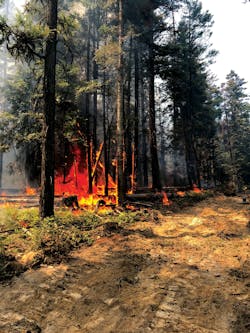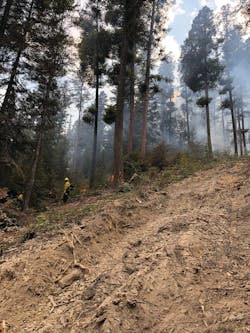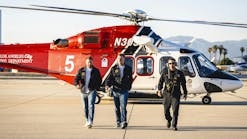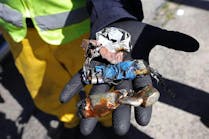When most fire department personnel think of wildland fires, their first thought might be about how fast they would need to put water on the fire. That’s understandable; that’s their structure-firefighting side coming out. However, crews and officers who might encounter wildland fires need to learn and embrace a different set of strategies and tactics.
Direct and indirect
The main concern of wildland firefighting is containment.
Every time that you hear of big fires out West, you hear the word “contained.” This refers to how much of the fire has been controlled and no longer is spreading. They will express this as a percentage. (Along with “contained,” you might hear “controlled” and “out.”)
Two strategies are used to achieve containment: direct fire attack and indirect fire attack. These somewhat correlate to offensive and defensive structure attacks, respectively.
Direct fire attack is a strategy in which you are in direct contact with the fire. This includes handline and machine line, but both within 100 feet of the fire’s edge. Any pockets of fuel can be cleaned up as a burn-out operation or be allowed to burn out on their own.
Direct fire attack is used for lighter fuels and for lower fire intensity—generally less than 4-foot flame heights. This strategy is preferred over indirect fire attack, because it allows direct and continuous observation of the fire. Parts of direct fire attack include: digging a fire line directly around the flames and pulling burned fuel into the black; using water; smothering; and removing an element from the fire triangle.
Indirect fire attack is used when you can’t safely engage directly, because the fire rate of spread is significant. (Several factors can accelerate the fire rate and spread. However, in general, flame height between 4–8 feet and winds that are faster than 8 mph indicate a significant fire rate of spread.)
The separation between the fire’s edge and resources can be as small as 100 yards or as much as numerous miles. This allows you to use natural barriers, such as trees or rocks, and man-made barriers and to take advantage of topographic tactical advantages and to set trigger points.
A lack of current fire behavior requires you to keep a very good hold on your LCES (Look Out, Communication, Escape Routes, Safety Zones) when using an indirect attack. Because of a large amount of unburned fuel, an indirect line is generally strengthened by conducting a backfire and using retardant to reduce spotting.
Back-burning is a tactic in which you burn unburned fuels between your fire line and the fire’s edge. This tactic helps to slow down the fire and to stop it from building momentum by the burning of more fuel.
That said, back-burning is a very technical strategy and only should be done by trained professionals. These larger operations require more planning, organization and qualifications to conduct. The location of indirect lines—and, therefore, the size of the fire—will be determined by your incident commander (IC) and operations section chief. Because larger amounts of natural resources with be affected, local jurisdictions also should have input into the strategy.Dig in
When it comes to tactics, the best bet for a municipal fire department is to get a good fire line started. A fire line is a line that’s between two and four feet wide that’s dug into the ground down to mineral soil. The line is dug with hand tools, such as a Pulaski, a combi tool, a shovel or a rake. (An IC’s access to a bulldozer will provide a better fire line around the fire and help with containment.)
If you can catch the fire quickly, you might be able to dig a fire line around the fire, particularly if it’s a slow burning rate and you have a good amount of help.
(If you’re a municipal department and you get a report of a wildland fire, you most likely will be dealing with something of the nature of a field that’s on fire. However, a report of a wildland fire to a fire department that serves a rural community might present a larger incident. Sometimes these fires can spread to homes and other structures. You likely will call for additional resources; many agencies might be involved.)
If you consider pulling hose to try to quickly extinguish the flames, be careful of the fire spread or ashes that action will create.
Fire departments that want to have a designated brush truck should know that these vehicles have a wide range of tank sizes, depending on the area to be encountered and pump sizes. The common Type 6 brush truck will have a tank size that ranges from 150 to 500 gallons and a pump that has a capacity of 50 to 100 gpm.
Brush trucks also carry hand tools, hoses and nozzles. It’s important for brush trucks to have hoses that are set to a progressive hoselay. This hoselay will have sections of hose that have a double shut of wye that’s attached to them. This makes it so that once a hoselay is laid out, another can attach and be set to the fire’s edge and a continuous water supply is available as you advance each hoselay.
Remember, safety is key to all of this. Over the years, many wildland firefighters died, but we must learn from mistakes that were made and from events over which we had no control, such as weather. In addition to having an LCES, consider the 10-18: 10 standard firefighting orders and 18 watch-out situations. Really read up on them, particularly if you plan to go out West to fight fires.
Mihku Sabattus
Mihku Sabattus is the assistant fire chief of the Passamaquoddy, ME, Fire Department. He wrote and received the 2018 FEMA Assistance to Firefighters Grant for the Indian Township, ME, Fire Department. Previously, Sabattus was a career firefighter with the Nashville, TN, Fire Department. Technical skills he learned included rope rescue, swift-water rescue, urban search and rescue and hazmat.







